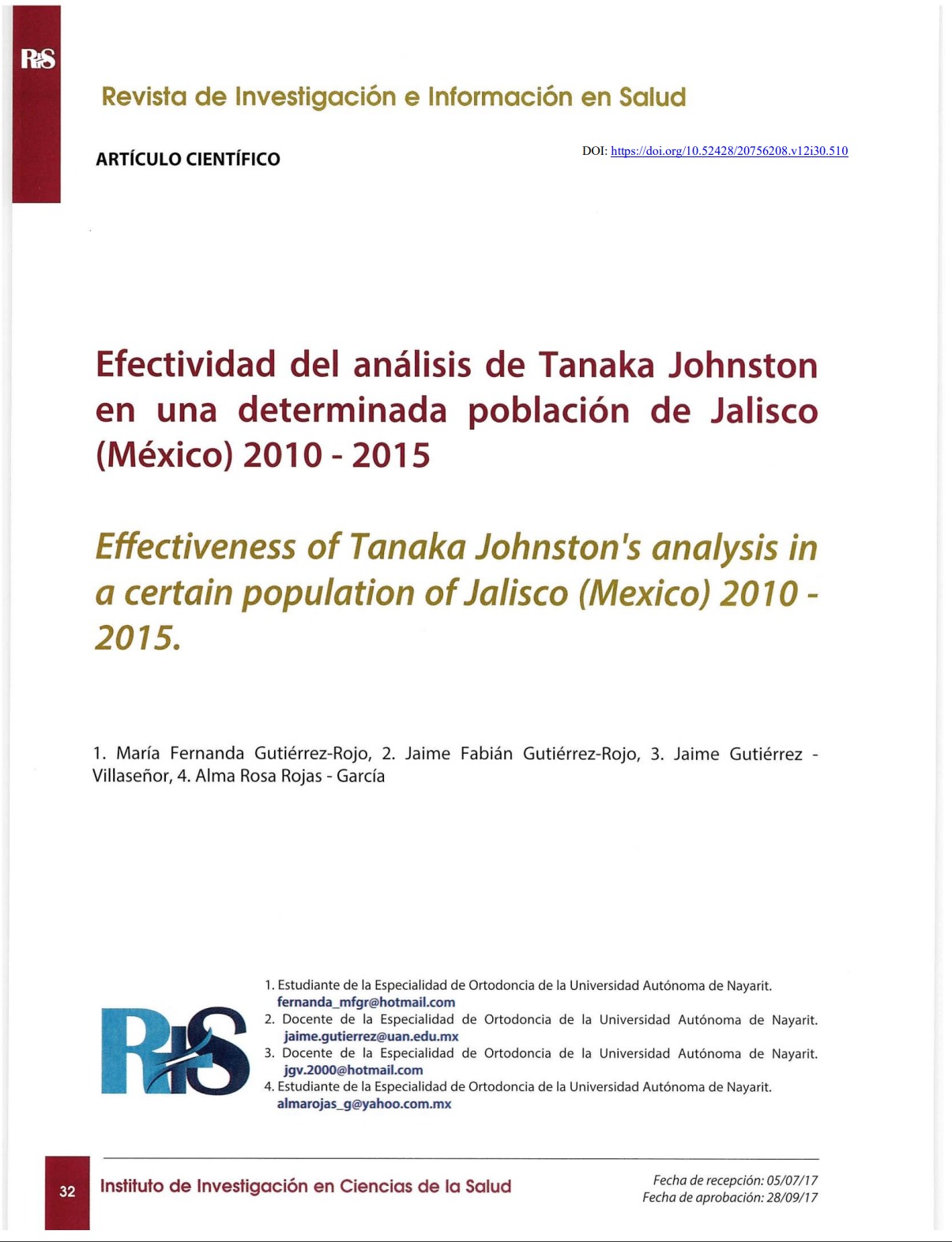Effectiveness of Tanaka Johnston's analysis in a certain population of Jalisco (Mexico) 2010-2015.
DOI:
https://doi.org/10.52428/20756208.v12i30.510Keywords:
Tanaka Johnston method, Mixed dentition, MalocclusionAbstract
The mixed dentition analysis Tanaka Johnston is used for orthodontic diagnosis, however this analysis can perform improper diagnosis because of differences in population's dental sizes. The Universe was 425 studied models orthodontic pretreatment study, the sample size was calculated and the result was 123 study models. The lower incisors, canines and premolars maxillary and mandibular models mesiodistally study measured the mixed dentition analysis of Tanaka and Johnston was applied. For data collection the Microsoft Office Excel 2007 and statistical program was held at the Stat Calc program was used. Statistically significant differences between calculated with the equation of Tanaka Johnston values and the values of the canines and premolars were found maxilla and mandible. It was moderate positive correlation between the predicted values and the values of the study population. Analysis of Tanaka Johnston is not effective for use in the study population because overestimates the values of the canine and premolars of the maxilla and mandible.
Downloads
References
ECHARRI P. Tratamiento ortodóncico y ortopédico de 1 a fase de dentición mixta. Madrid. 2da edición. 2010. 84-7
GUTIÉRREZ-ROJO J, ROJAS-GARCÍA A. Ajuste y evaluación de las constantes de regresión lineal para el análisis de dentición mixta. Acta Odontológica Colombiana. 2013; 3 (1): 31-37.
GUPTA M, BAHL R, GIRDHAR P, KUMAR M. Mixed dentition analysis. Asia Pacific Dental Journal. 2015; 2 (2): 24-27.
PROFFIT W. Ortodoncia Teoría y Práctica. St. Luois. 4a edición. Mosby. 2007. 197-201.
RAKOSI T, JONAS l. Atlas de Ortopedia maxilar: diagnóstico. Editorial Masson. 1992. Barcelona. 219-221
MOYERS R. Manual de Ortodoncia. Buenos Aires. Cuarta Edición. 1998. Panamericana. 237-42.
PROFFIT W, ACKERMAN J. Capítulo 6. Diagnóstico ortodóncico: establecimiento de un listado de problemas. en: Proffit W. White R. Sarver D. Contemporary treatment of Dentofacial Deformity. Mosby 2003. 148 y 168.
GUTIÉRREZ-ROJO J, ROJAS-GARCÍA A, LEMUS-FLORES C, REYES-MALDONADO Y. Ajuste por género del análisis de Tanaka Johnston en la predicción del tamaño mesiodistal de premolares y caninos en una población de Nayarit. Revista ORAL. 2012; 13 (41). 870-872.
TANAKA M, JOHNSTON L. The prediction of the size of unerupted canines and premolars in a contemporary orthodontic population. J Am Den Assoc. 1974; 88:798-801.
AQUINO C, TIRRE M, OLIVEIRA A. Applicability of Three tooth size prediction Methods for White Brazilians. Angle Orthodontist. 2006; 76
BERWANI A, FIDA M. Development of prediction equation for the mixed dentition in a Pakistani simple. Am J Orthod Dentofacial Orthop. 201 1; 140: 626-32.
BOBOC A, Dibbets J. Prediction of the mesiodistal width of unerupted permanent canines and premolars: A statistical approach. Am J Orthod Dentofacial Orthop. 2010; 137: 503-7.
CABELLO N, MENDOZA V, PARÉS F. Valoraciön de la exactitud de predicci6n del tamaho dental mesiodistal de las tablas de probabilidad de Moyers y las ecuaciones de Tanaka Johnston en una poblaci6n mexicana. Revista ADM. 2004; XLI (5): 176-82.
TELEBI V, MAHMOOD H, GAHANI H. An investigation to determine the validity of Tanaka Johnston method for estimating the mesi odistal with of permanent canine and premolars in sample population of Ghazvin city. Journal of Dentistry. 2003; 16 (2):53-59
BHERWANI A, FIDA M. Development of a prediction equation for the mixed dentition in Pakistani sample. Am J Orthod Dentofacial Orthop. 201 1; 140: 626-32.
JUNEJA S, MAHAJAN N, KAUR H, GUPTA K, SUKHIJA M, BHAMBRE E. Comparative evaluation of three mixed dentition analyses and formulation of regression equations for north Indian population: a cross-sectional study. Biomed J. 2015; 38 (5): http://biomedj.org/temp/ BiomedJ385450-7435327_203913.pdf
LEE-CHAN S, JACOBSON B, CHWA K, JACOBSON R. Mixed dentition analysis for Asian Americans. Am J Dentofacial Orthop. 1 998; 1 1 3:2939.
BUGAOGHIS l, KARANTH D, ELMOUADEB H. Mixed dentition analysis in Libyan schoolchildren. Journal of Orthodontic Science. 2013; 2 (4): 1 15-9.
Arslan S, Dildes N, Kama J, Genc C. Mixed-dentition analysis in a Turkish population. World J Orthod. 2009; 10: 135-40.
Al Bitar Z, Al Omar l, Sonbol H, Al Ahmad H, Hamdan A. Mixed Dentition Analysis in a Jordanian Population. Angle Orthod. 2008; 78 (4): 670-5.
Kuswandari S, Nishino M, Arita K, Abe Y. Mixed dentition space analysis for indonesian Javanese children. Pediatric Dental Journal. 2006; 16 (1): 74-83.
Hammand S, Abdellatif A. Mixed dentition space analysis in Egyptian children. Pediatric Dental Journal. 201 0; 20 (2):1 15-121.
Botero P, Cuesta D, Agudelo S, Hincapie C, Ramirez C. Valoraciön de los métodos de anålisis de denticiön mixta de Moyers y TanakaJohnston, en la predicciön del diåmetro mesiodistal de caninos y premolares no erupcionados. Rev Facultad de Odontologia Universidad Antioquia 2014;25
GUTIÉRREZ-ROJO J, ROJAS-GARCIA A, LEMUS-FLORES C, REYES-MALDONADO Y. Efectividad del Anålisis de Tanaka Johnston en una poblaciån de Nayarit. Revista Oral. 201 1; 12 (39): 795-8.
DURAN-PADILLA G, GUTIÉRREZ-ROJO J, MONTIEL-MILONAS R. Validaciön del anålisis de Tanaka Johnston en una poblaciön de Aguascalientes. Memoria del XLVII congreso de la Asociaciön Mexicana de Ortodoncia 2014. Concurso de estudiantes de postgrado.

Downloads
Published
How to Cite
Issue
Section
License
Copyright (c) 2017 María Fernanda Gutiérrez-Rojo, Jaime Fabián Gutiérrez Rojo, Jaime Gutiérrez Villaseñor y Alma Rosa Rojas García

This work is licensed under a Creative Commons Attribution 4.0 International License.
Authors who publish with this journal agree to the following terms:
- Authors retain copyright and grant the journal right of first publication with the work simultaneously licensed under a Creative Commons Attribution License 4.0 that allows others to share the work with an acknowledgement of the work's authorship and initial publication in this journal.
- Authors are able to enter into separate, additional contractual arrangements for the non-exclusive distribution of the journal's published version of the work (e.g., post it to an institutional repository or publish it in a book), with an acknowledgement of its initial publication in this journal.
- Authors are permitted and encouraged to post their work online (e.g., in institutional repositories or on their website) prior to and during the submission process, as it can lead to productive exchanges, as well as earlier and greater citation of published work.






















